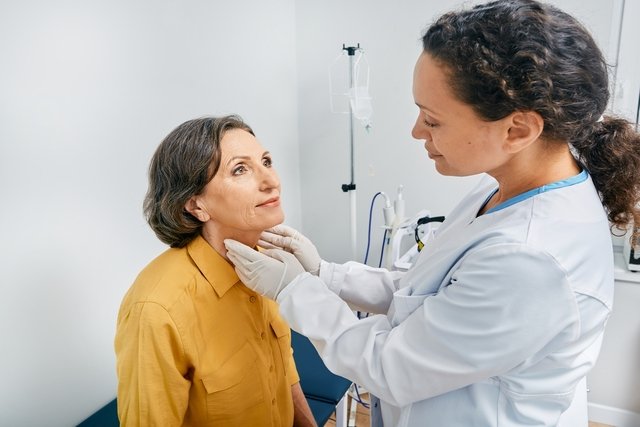Autoimmune diseases are those characterized by the immune system’s response against the body itself, in which healthy cells are destroyed by the immune system.
The main autoimmune diseases are lupus, rheumatoid arthritis, hemolytic anemia and Crohn’s disease, for example, which must be identified and treated according to the doctor’s advice.
The diagnosis of autoimmune diseases is normally made by observing the signs and symptoms presented by the person, which vary according to the disease, and through immunological, molecular and imaging tests.

Main diseases
The main autoimmune diseases are:
1. Systemic Lupus Erythematosus
Systemic lupus erythematosus, also known as SLE, is an autoimmune disease in which the body’s defense cells attack the body’s healthy cells, resulting in inflammation in the joints, eyes, kidneys and skin, for example.
Main symptoms: The main symptom of SLE is the appearance of a butterfly-shaped red spot on the face, in addition to joint pain, excessive tiredness and the appearance of sores in the mouth and nose.
Lupus symptoms appear in outbreaks, that is, the person has periods without symptoms and others with symptoms, and this period is normally triggered by factors that interfere with the functioning of the immune system or that favor the appearance of clinical manifestations, such as the use of some medications or prolonged exposure to the sun.
How is the treatment: Treatment for SLE must be carried out according to the recommendation of a rheumatologist or general practitioner and aims to alleviate symptoms and prevent them from appearing frequently and extensively, as this disease has no cure. Therefore, the doctor may recommend the use of anti-inflammatory medications, corticosteroids and immunosuppressants.
Understand how systemic lupus erythematosus is diagnosed and treated.
2. Rheumatoid arthritis
Rheumatoid arthritis is characterized by inflammation and swelling of the joints due to the action of the immune system against the body itself. The cause of rheumatoid arthritis is not yet well understood, but it is believed that some factors may favor the development of this disease, such as infection by viruses or bacteria, for example.
Main symptoms: Symptoms of rheumatoid arthritis can appear and disappear without any explanation, the main ones being redness, swelling and pain in the joint. In addition, stiffness and difficulty moving the joint, fever, tiredness and malaise may be observed. Know how to recognize the symptoms of rheumatoid arthritis.
How is the treatment: Treatment must be recommended by a rheumatologist or general practitioner, and the use of anti-inflammatory medications is normally recommended to reduce inflammation and alleviate symptoms. Furthermore, it is important that physiotherapy is carried out to prevent limitations in the range of motion of the joint.
3. Multiple sclerosis
Multiple sclerosis is characterized by the destruction of the myelin sheath, which is the structure that covers neurons and allows the transmission of nerve impulses through the cells of the immune system, resulting in impairment of the nervous system.
Main symptoms: The symptoms of multiple sclerosis are progressive, that is, they worsen as the nervous system is compromised, resulting in muscle weakness, excessive tiredness, tingling in the arms or legs, difficulty walking, fecal or urinary incontinence, visual changes and memory loss. , for example. Therefore, as the disease progresses, the person becomes increasingly dependent, which directly interferes with their quality of life.
How is the treatment: Treatment for multiple sclerosis typically involves the use of medications to prevent the progression of the disease and to promote symptom relief, such as anti-inflammatories, immunoglobulins and corticosteroids. Furthermore, it is important that the person performs physical therapy sessions regularly so that the muscles are constantly activated and, thus, complete atrophy can be avoided.
4. Tireoidite de Hashimoto
Hashimoto’s thyroiditis is characterized by inflammation of the thyroid due to the immune system attacking thyroid cells, resulting in increased or normal thyroid activity, which is soon followed by low activity, resulting in hypothyroidism.
Main symptoms: Symptoms related to Hashimoto’s thyroiditis are similar to those of hypothyroidism, including excessive tiredness, hair loss, cold and pale skin, low intolerance to cold, easy weight gain and muscle or joint pain.
As the symptoms of Hashimoto’s thyroiditis are the same as those of hypothyroidism, the endocrinologist needs the person to carry out some tests that evaluate the functioning of the thyroid so that the autoimmune disease can be confirmed and, thus, the most appropriate treatment can be initiated. See more about the symptoms of Hashimoto’s thyroiditis.
How is the treatment: Treatment for Hashimoto’s thyroiditis is only indicated by an endocrinologist when the person presents symptoms, and in these cases hormone replacement therapy with Levothyroxine is recommended for a period of 6 months. It is also important to pay attention to your diet, eating foods rich in iodine, zinc and selenium, for example, which are nutrients that promote the proper functioning of the thyroid.
5. Hemolytic anemia
Hemolytic anemia occurs when the immune system starts to produce antibodies that act by destroying red blood cells, causing anemia. This type of anemia is more common in young adults and it is not yet known exactly why antibodies are produced against red blood cells, however it is believed that deregulation of the immune system due to some infection, the use of some medications or the presence of an autoimmune disease may favor the occurrence of hemolytic anemia.
Main symptoms: The symptoms of hemolytic anemia are related to a decrease in the amount of red blood cells, hemoglobin and, consequently, oxygen circulating in the blood, with weakness, paleness, loss of appetite, headache, weak nails, memory failure, dry skin and indisposition. .
How is the treatment: The treatment indicated by the doctor usually involves the use of medications to regulate the activity of the immune system, such as corticosteroids and immunosuppressants. Furthermore, in some cases, the doctor may recommend removing the spleen, called splenectomy, as it is in this organ that the red blood cells are destroyed. Understand how hemolytic anemia is treated.
6. Vitiligo
Vitiligo is a disease characterized by the destruction of melanocytes, which are the cells responsible for producing melanin, the substance responsible for skin color. The cause of vitiligo is not yet well understood, however it is often associated with dysregulation of the immune system, leading to the destruction of melanocytes by the immune system’s own cells.
Main symptoms: Due to the destruction of melanin-producing cells, several white spots appear on the skin, which is characteristic of vitiligo. These spots appear more frequently in places that are more exposed to the sun, such as hands, arms, face and lips.
How is the treatment: The treatment of vitiligo must be guided by a dermatologist, as the person needs to take different care of their skin, as it becomes more sensitive, in addition to being necessary to use creams and ointments with corticosteroids or immunosuppressants, in addition to the need for phototherapy. . Check out the main forms of treatment for vitiligo.
7. Sjögren’s syndrome
Sjögren’s syndrome is characterized by the production of autoantibodies responsible for chronic and progressive inflammation of the body’s glands, such as salivary and lacrimal glands, resulting in dry mucous membranes.
Main symptoms: As the glands responsible for hydrating the eyes and mouth are affected, for example, the main symptoms observed are dry eyes and mouth, difficulty swallowing, difficulty speaking for a long time, greater sensitivity to light, a sensation of redness in the eyes and increased the risk of infections.
This disease can occur solely due to changes in immunity or associated with other autoimmune diseases, such as rheumatoid arthritis, lupus and scleroderma. Therefore, it is important that the doctor requests autoantibody testing to check whether there is another associated disease and, in this way, recommend the best treatment.
How is the treatment: The treatment indicated by the doctor aims to alleviate the symptoms presented and the use of artificial saliva and lubricating eye drops may be indicated, in addition to anti-inflammatory and immunosuppressive medications. See other treatment options for Sjogren’s syndrome.
8. Type 1 diabetes
Type 1 diabetes is also an autoimmune disease, because it occurs due to the attack by immune cells on the pancreatic cells responsible for insulin production, with no recognition of the amount of circulating glucose, which causes more and more glucose to be accumulated in the blood. It is more common in children and adolescents, but can also happen in young adults.
Main symptoms: The main symptoms related to type 1 diabetes are the frequent urge to urinate, extreme thirst, excessive hunger and weight loss for no apparent reason.
It is important that the doctor performs other tests in addition to fasting glucose and glycated hemoglobin to diagnose type 1 diabetes, as the symptoms are similar to those of type 2 diabetes. Know the difference between type 1 and type 2 diabetes.
How is the treatment: For this type of diabetes, the endocrinologist must recommend the use of insulin in several doses during the day or in the form of a pump, because the pancreas is unable to produce insulin. This way, it is possible to keep circulating blood glucose levels regulated.
9. Celiac disease
Celiac disease is an autoimmune disease characterized by intolerance to gluten present in food, as the body does not produce sufficient amounts of enzymes to degrade this protein, resulting in an exacerbated immune system response, which leads to inflammation and the appearance of lesions in the intestine. .
Main symptoms: The symptoms of celiac disease are identified after consuming foods that contain gluten in their composition, and their intensity may vary from person to person according to the degree of intolerance. The main symptoms indicative of celiac disease are vomiting, weight loss, frequent diarrhea, swollen belly, very large, pale and foul-smelling stools. Know how to recognize the symptoms of celiac disease.
How is the treatment: Treatment for celiac disease consists of controlling symptoms, and it is recommended to avoid the consumption of foods that contain gluten or traces of gluten, as well as the use of dietary supplements to avoid complications, as the doctor or nutritionist may recommend it. Inflammation and damage to the intestine can interfere with nutrient absorption.

Sign up for our newsletter and stay up to date with exclusive news
that can transform your routine!
Warning: Undefined array key "title" in /home/storelat/public_html/wp-content/plugins/link-whisper-premium/templates/frontend/related-posts.php on line 12
Warning: Undefined array key "title_tag" in /home/storelat/public_html/wp-content/plugins/link-whisper-premium/templates/frontend/related-posts.php on line 13



